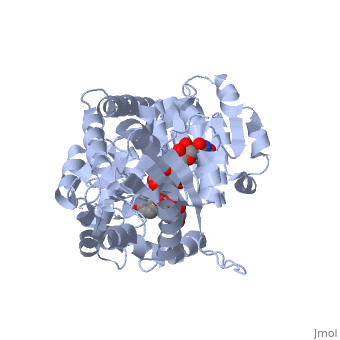2c1z
From Proteopedia
(Difference between revisions)
| Line 3: | Line 3: | ||
<StructureSection load='2c1z' size='340' side='right'caption='[[2c1z]], [[Resolution|resolution]] 1.90Å' scene=''> | <StructureSection load='2c1z' size='340' side='right'caption='[[2c1z]], [[Resolution|resolution]] 1.90Å' scene=''> | ||
== Structural highlights == | == Structural highlights == | ||
| - | <table><tr><td colspan='2'>[[2c1z]] is a 1 chain structure with sequence from [ | + | <table><tr><td colspan='2'>[[2c1z]] is a 1 chain structure with sequence from [https://en.wikipedia.org/wiki/Grape Grape]. Full crystallographic information is available from [http://oca.weizmann.ac.il/oca-bin/ocashort?id=2C1Z OCA]. For a <b>guided tour on the structure components</b> use [https://proteopedia.org/fgij/fg.htm?mol=2C1Z FirstGlance]. <br> |
| - | </td></tr><tr id='ligand'><td class="sblockLbl"><b>[[Ligand|Ligands:]]</b></td><td class="sblockDat"><scene name='pdbligand=KMP:3,5,7-TRIHYDROXY-2-(4-HYDROXYPHENYL)-4H-CHROMEN-4-ONE'>KMP</scene>, <scene name='pdbligand=U2F:URIDINE-5-DIPHOSPHATE-2-DEOXY-2-FLUORO-ALPHA-D-GLUCOSE'>U2F</scene></td></tr> | + | </td></tr><tr id='ligand'><td class="sblockLbl"><b>[[Ligand|Ligands:]]</b></td><td class="sblockDat" id="ligandDat"><scene name='pdbligand=KMP:3,5,7-TRIHYDROXY-2-(4-HYDROXYPHENYL)-4H-CHROMEN-4-ONE'>KMP</scene>, <scene name='pdbligand=U2F:URIDINE-5-DIPHOSPHATE-2-DEOXY-2-FLUORO-ALPHA-D-GLUCOSE'>U2F</scene></td></tr> |
| - | <tr id='related'><td class="sblockLbl"><b>[[Related_structure|Related:]]</b></td><td class="sblockDat">[[2c1x|2c1x]], [[2c9z|2c9z]]</td></tr> | + | <tr id='related'><td class="sblockLbl"><b>[[Related_structure|Related:]]</b></td><td class="sblockDat"><div style='overflow: auto; max-height: 3em;'>[[2c1x|2c1x]], [[2c9z|2c9z]]</div></td></tr> |
| - | <tr id='activity'><td class="sblockLbl"><b>Activity:</b></td><td class="sblockDat"><span class='plainlinks'>[ | + | <tr id='activity'><td class="sblockLbl"><b>Activity:</b></td><td class="sblockDat"><span class='plainlinks'>[https://en.wikipedia.org/wiki/Flavonol_3-O-glucosyltransferase Flavonol 3-O-glucosyltransferase], with EC number [https://www.brenda-enzymes.info/php/result_flat.php4?ecno=2.4.1.91 2.4.1.91] </span></td></tr> |
| - | <tr id='resources'><td class="sblockLbl"><b>Resources:</b></td><td class="sblockDat"><span class='plainlinks'>[ | + | <tr id='resources'><td class="sblockLbl"><b>Resources:</b></td><td class="sblockDat"><span class='plainlinks'>[https://proteopedia.org/fgij/fg.htm?mol=2c1z FirstGlance], [http://oca.weizmann.ac.il/oca-bin/ocaids?id=2c1z OCA], [https://pdbe.org/2c1z PDBe], [https://www.rcsb.org/pdb/explore.do?structureId=2c1z RCSB], [https://www.ebi.ac.uk/pdbsum/2c1z PDBsum], [https://prosat.h-its.org/prosat/prosatexe?pdbcode=2c1z ProSAT]</span></td></tr> |
</table> | </table> | ||
== Function == | == Function == | ||
| - | [[ | + | [[https://www.uniprot.org/uniprot/UFOG_VITVI UFOG_VITVI]] In the presence of other necessary color factors, this glycosylation reaction allows the accumulation of anthocyanin pigments. Involved in the formation of red wine pigments. Can use UDP-Glc, UDP-5SGlc, UDP-Xyl, UDP-Man, UDP-Gal, UDP-GlcNAc, GDP-Glc, dTDP-Glc and dTDP-Xyl as sugar donor, but not UDP-6OMeGal, UDP-Ara, UDP-6FGal, UDP-GlcN, UDP-2FGal, UDP-5SAra, GDP-Man, GDPFuc, UDP-Fuc or UDP-Rha. Cyanidin is the natural acceptor, but quercitin and kaempferol can also be glucosylated. |
== Evolutionary Conservation == | == Evolutionary Conservation == | ||
[[Image:Consurf_key_small.gif|200px|right]] | [[Image:Consurf_key_small.gif|200px|right]] | ||
| Line 33: | Line 33: | ||
==See Also== | ==See Also== | ||
*[[Glycosyltransferase 3D structures|Glycosyltransferase 3D structures]] | *[[Glycosyltransferase 3D structures|Glycosyltransferase 3D structures]] | ||
| - | *[[Vitis vinifera Flavonoid 3-O-Glucosyltransferase (Vv3GT)|Vitis vinifera Flavonoid 3-O-Glucosyltransferase (Vv3GT)]] | ||
== References == | == References == | ||
<references/> | <references/> | ||
Revision as of 06:46, 1 December 2021
Structure and activity of a flavonoid 3-O glucosyltransferase reveals the basis for plant natural product modification
| |||||||||||


